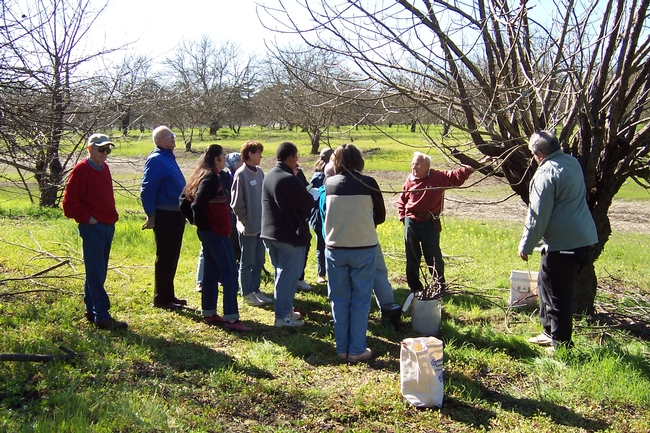
Then I knew it was time to prune, and I felt faced with a daunting task. The first thought that came to mind was the medical principle: Do no harm.
I knew that I needed sharp tools so I got out my pruning shears and loppers. With the help of a little steel wool, a sharpening stone and a few drops of mineral oil, my pruning arsenal was ready for deployment.
After spending what seemed like hours reviewing each of my 10 fruit trees, I concluded that I had no idea what I was doing. Pruning was not going to be the easy task I had envisioned, and I was concerned about violating the “Do no harm” rule. Research was required.
Thanks to several books and the Internet, I developed a better understanding of pruning, starting with why it's necessary. Top three reasons: You prune to strengthen the branching structure;to control tree size for ease of harvesting; and to both promote and control fruit production. Lastly, at least to me, you prune for aesthetic appeal. I care less about how the tree looks and more about how much fruit it produces and how the fruit tastes.
After my research, I was able to formulate a general pruning approach. By general, I mean that fruit-tree pruning is not a one-size-fits-all endeavor. Different trees have different needs.
Start by removing any dead, damaged or diseased branches. Dead wood will be dark or brittle, often with the bark falling away. Diseased wood is often a different color than the other branches. You can, and should, prune dead, damaged and diseased wood at any time of year. Whenremoving diseased wood, be sure to clean your toolsafterward so you not spread disease to other trees. Use a solution of 10 percent bleach and 90 percent water.
Next, remove any suckers, the branches growing from the base of the tree. Then cut off any water sprouts, thin branches that usually grow straight up. They will never bear fruit, and they just sap energy from the plant. Removing them early in the pruning process will help you see the structure of your tree and make it easier to see where further cuts are needed.
Prune out downward-facing branches as they will be shaded and won't be productive. Remove any branches that cross or rub against larger branches. Over time, the sustained rubbing would damage both branches.Each branch that remains should create an angle of at least 45 degrees.
Now focus on thinning interior branches so that sunlight can reach all the fruit. Light penetration is essential for flower-bud development and for optimal fruit set, flavor and quality. Be ruthless. You can safely remove up toone-third of the branches. Cut off all spindly growth.
Although a mature tree may be growing in full sun, a dense canopy may not allow enough light to reach the interior. Thinning the canopy also enhances air flow through the tree, minimizing the risk of fungal diseases.
Last but not least, prune your fruit trees to the desired height. I don't want to get out a ladder every time I want an apple or peach, so about eight feet is the maximum height for me.
After you finish pruning, practice good sanitation and cleanup the area. Remove fallen leaves, mummified fruit remains, twigs and branches. I put everything except diseased wood in my compost pile. The diseased wood goes into the yard-waste bin.
I have covered what you should do. Now I'll mention acommon practice to avoid. Do not apply sealing compounds or dressing to pruning wounds. Research shows that these materials seal in moisture, which promotes rot. Leave the cuts open so they can dry and heal naturally.
Now it's time to sit back, relax and dream about sampling the year's first peach, apple or plum. You've earned it.
Pruning Workshop: Napa County Master Gardeners will host a workshop on “Fruit Tree Pruning” on Saturday, February 22, from 9:30 a.m. to 11:30 a.m. (indoor lecture) and from 12:30 p.m. to 2:30 p.m. (outdoor hands-on workshop). Lecture location is the University of California Cooperative Extension, 1710 Soscol Avenue, Napa. Outdoor location to be determined.Now is the best time to prune your fruit trees. Learn techniques to keep them healthy and productive. Please dress for outdoor weather. Online registration (credit card only) Mail in registration (cash or check only)
Napa County Master Gardeners welcome the public to visit their demonstration garden at Connolly Ranch on Thursdays, from 10:00 a.m. until noon, except the last Thursday of the month. Connolly Ranch is at 3141 Browns Valley Road at Thompson Avenue in Napa. Enter on Thompson Avenue.
Master Gardeners are volunteers who help the University of California reach the gardening public with home gardening information. Napa County Master Gardeners ( http://ucanr.org/ucmgnapa/) are available to answer gardening questions in person or by phone, Monday, Wednesday and Friday, 9 a.m. to Noon, at the U. C. Cooperative Extension office, 1710 Soscol Avenue, Suite 4, Napa, 707-253-4143, or from outside City of Napa toll-free at 877-279-3065. Or e-mail your garden questions by following the guidelines on our web site. Click on Napa, then on Have Garden Questions? Find us on Facebook under UC Master Gardeners of Napa County